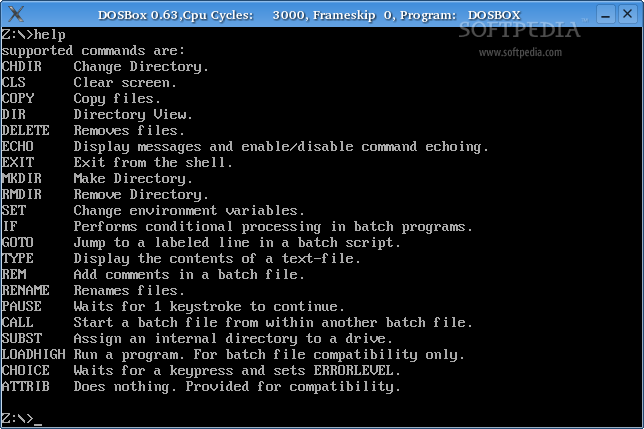

- Run dosbox full screen driver#
- Run dosbox full screen code#
- Run dosbox full screen Pc#
- Run dosbox full screen plus#
- Run dosbox full screen series#
Run dosbox full screen code#
A kernel, the COMMAND.COM command line interpreter (shell), and core utilities were created by pooling code they had written or found available.

Within a few weeks, other programmers including Pat Villani and Tim Norman joined the project. Jim Hall then posted a manifesto proposing the development of an open-source replacement. The FreeDOS project began on 26 June 1994, when Microsoft announced it would no longer sell or support MS-DOS. The last retail version of PC DOS was PC DOS 2000 (also called PC DOS 7 revision 1), though IBM did later develop PC DOS 7.10 for OEMs and internal use. The last retail version of MS-DOS was MS-DOS 6.22 after this, MS-DOS became part of Windows 95, 98 and Me. They split development of their DOS systems as a result.
Run dosbox full screen series#
The two companies later had a series of disagreements over two successor operating systems to DOS, OS/2 and Windows.

After AT&T began selling Unix, Microsoft and IBM began developing OS/2 as an alternative. IBM, however, did not want to replace DOS. OS/2 1.0 featured a text mode interface similar to MS-DOS. The company planned to improve MS-DOS over time, so it would be almost indistinguishable from single-user Xenix, or XEDOS, which would also run on the Motorola 68000, Zilog Z-8000, and LSI-11 they would be upwardly compatible with Xenix, which BYTE in 1983 described as "the multi-user MS-DOS of the future". Microsoft expected that it would be an interim solution before Xenix. Gordon Letwin wrote in 1995 that "DOS was, when we first wrote it, a one-time throw-away product intended to keep IBM happy so that they'd buy our languages". Digital Research was bought by Novell, and DR DOS became PalmDOS and Novell DOS later, it was part of Caldera (under the names OpenDOS and DR-DOS 7.02/ 7.03), Lineo, and DeviceLogics.
Run dosbox full screen plus#
This version of DOS is distinct from the widely released PC DOS 4.0 which was developed by IBM and based upon DOS 3.3.ĭigital Research CP/M-86 for the IBM Personal Computer Version 1.0ĭigital Research attempted to regain the market lost from CP/M-86, initially with Concurrent DOS, FlexOS and DOS Plus (both compatible with both MS-DOS and CP/M-86 software), later with Multiuser DOS (compatible with both MS-DOS and CP/M-86 software) and DR DOS (compatible with MS-DOS software). None of these features were used in later versions of DOS, but they were used to form the basis of the OS/2 1.0 kernel. This version of DOS supports preemptive multitasking, shared memory, device helper services and New Executable ("NE") format executables. This version of DOS is generally referred to as "European MS-DOS 4" because it was developed for ICL and licensed to several European companies. In the mid-1980s Microsoft developed a multitasking version of DOS.
Run dosbox full screen Pc#
By the early 1990s, most PCs adhered to IBM PC standards so Microsoft began selling MS-DOS in retail with MS-DOS 5.0.
Run dosbox full screen driver#
Microsoft provided an OEM Adaptation Kit (OAK) which allowed OEMs to customize the device driver code to their particular system. DOS was structured such that there was a separation between the system specific device driver code ( IO.SYS) and the DOS kernel ( MSDOS.SYS). One major reason for this was that not all early PCs were 100% IBM PC compatible. Microsoft originally sold MS-DOS only to original equipment manufacturers (OEMs). CP/M faded, with MS-DOS and PC DOS becoming the marketed operating system for PCs and PC compatibles. Side-by-side, CP/M cost US$200 more than PC DOS, and sales were low. IBM responded by offering an agreement: they would give PC consumers a choice of PC DOS or CP/M-86, Kildall's 8086 version. Digital Research became aware that an operating system similar to CP/M was being sold by IBM (under the same name that IBM insisted upon for CP/M), and threatened legal action. IBM continued to develop their version, PC DOS, for the IBM PC. Microsoft later required the use of the MS-DOS name, with the exception of the IBM variant. Within a year Microsoft licensed MS-DOS to over 70 other companies, which supplied the operating system for their own hardware, sometimes under their own names. This became Microsoft Disk Operating System, MS-DOS, introduced in 1981. Microsoft purchased 86-DOS, allegedly for US$50,000. The system was initially named QDOS (Quick and Dirty Operating System), before being made commercially available as 86-DOS. There, programmer Tim Paterson had developed a variant of CP/M-80, intended as an internal product for testing SCP's new 16-bit Intel 8086 CPU card for the S-100 bus. Gates in turn approached Seattle Computer Products.


 0 kommentar(er)
0 kommentar(er)
